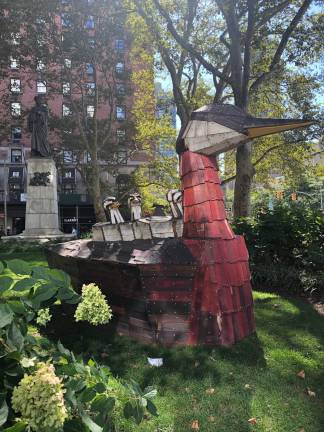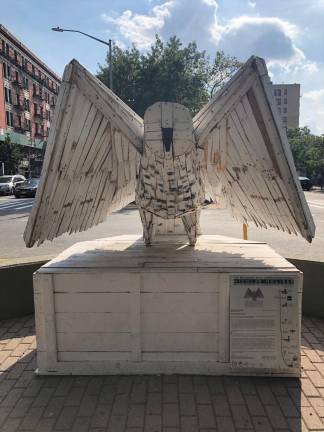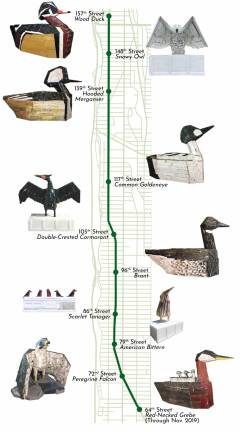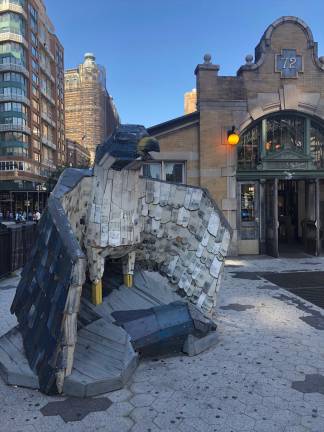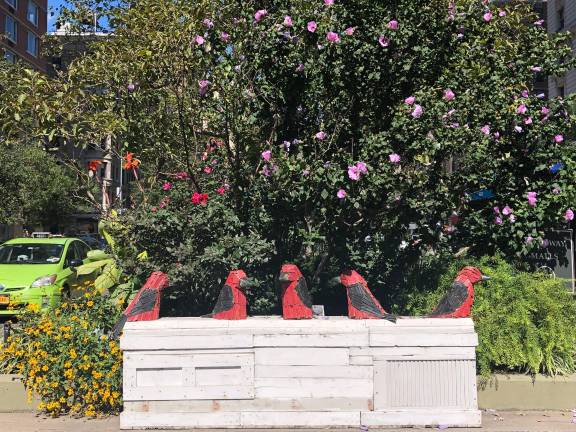Call it a show for the birds — an open-air exhibition on the Broadway Malls that raises awareness of avian species threatened or endangered by global warming, according to the 2014 National Audubon Society study, “Birds and Climate Change Report.”
On view through January 2020, “Nicolas Holiber: Birds on Broadway, the Audubon Sculpture Project” is a sequel to the ongoing Audubon Mural Project in Harlem and Washington Heights. The giant sculptures, inspired by the illustrations of renowned ornithologist John James Audubon (1785-1851), first popped up on the Broadway greenways in May. They assumed even more relevance in the last month when scientists published a study concluding that the number of birds in the U.S. and Canada had dropped by nearly 30 percent since 1970.
According to the Audubon Society’s reckoning, more than half of all North American bird species are “likely to be in trouble,” the result of shifting and contracting habitat zones from a warming climate. Of the 145 at risk species that reside in or transit through New York City, Brooklyn-based artist Nicolas Holiber singled out 10 to spread their wings on the legendary boulevard, from Dante Park at 64th Street to 157th Street in Washington Heights, adjacent to Audubon Terrace.
Holiber, 34, told us in an email that the works were constructed in two warehouses over the course of about a year — one in Flatbush, Brooklyn, the other in Long Island City, Queens. He had one assistant, Bishop McIndoe, who helped him several days a week.
"Alarming Message"
In a bow to the environment, each piece is made entirely of reclaimed lumber. “The only other materials are paint and the hardware keeping each piece of wood together. The reclaimed wood is significant because it meant that I did not have to use newly harvested lumber, and I was able to keep things out of the trash cycle,” Holiber said.
“It also provides a unique connection to the exhibition’s alarming message about climate change. The reclaimed lumber, although painted, is not weatherproofed. The sculptures are left untreated to allow for the city’s natural forces to affect them, highlighting the environmental challenges faced by each species in the wild.”
Sites along Broadway were carefully evaluated prior to construction. “I chose these specific locations because I thought the placement would take New Yorkers by surprise and remind them that the urban environment is a natural environment.”
The Red-Necked Grebe, with three adorable chicks on its back, is situated across from Lincoln Center at 64th Street, followed in a neat northerly line by: the Peregrine Falcon at 72nd; the American Bittern at 79th; five Scarlet Tanagers at 86th; the Brant at 96th; the Double-Crested Cormorant at 105th; the Common Goldeneye at 117th; the Hooded Merganser at 139th; the Snowy Owl at 148th; and, in a splashy finale, the vividly colored Wood Duck at 157th.
A Kickstarter Campaign
As with any public art installation, especially one of this magnitude, it takes a village to pull it off — in this case, the artist, gallerist Avi Gitler, the Broadway Mall Association, the New York City Department of Parks & Recreation and New York City Audubon, the project’s fiscal sponsor. Corporate backing and donations from individuals through a Kickstarter campaign were crucial to making it happen.
The Broadway Mall Association is tasked with both maintaining the plantings along this five-mile-long “linear park” — in partnership with NYC Parks, which owns the land — and mounting contemporary art exhibitions, something it has been doing nearly every year since 2005. Artists whose works have seeded the parkland include Tom Otterness, Joy Brown, Saint Clair Cemin, Dan Colen, Carole Eisner, Don Gummer, Kathy Ruttenberg, Manolo Valdés and Peter Woytuk.
Said Deborah Foord, Chair of the Broadway Mall Association’s Public Art Committee: “The Broadway Malls offer environmental advantages for the West Side and the city, providing green space and bird habitat. People like the birds. Feedback indicates that the public appreciates having art on the malls, and this exhibition in particular makes them think about climate change and the many ways in which we and others green New York City.”
Holiber, who has an MFA from the New York Academy of Art, is not new to the public art realm. His large-scale “Head of Goliath” debuted in Tribeca Park in 2015 and was on display for six months. About his latest foray, he said, “Since I was young, I have been in awe of predatory birds. I’m always on the lookout for something flying around in the sky or perching in a tree.”
What’s next for birdman? “I would be thrilled to continue working on public art projects that are environmental in nature. At the moment, I’m building a new body of paintings and sculptures to be exhibited in 2020 ... People have been visiting the sculptures non-stop since they were installed in May and show a real concern for the project’s environmental message.”
